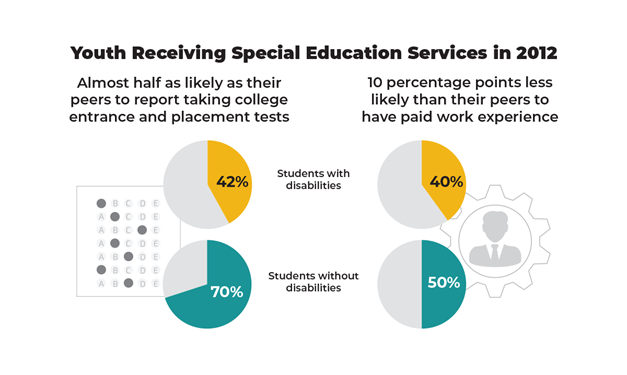Transitioning from high school to the next step can be both exciting and daunting. Do you remember participating in school activities, getting that first job (Staples and the ballpark concession stand for us!), studying for the SAT, and filling out college applications—all in the hopes of creating the future you imagined after high school? Maybe you waited in anticipation for a college acceptance letter, a job offer, or acceptance into the military.
As familiar as these stories might sound, it’s not reality for many high school students, particularly those with disabilities. According to the National Center for Education Statistics, students with disabilities are less likely than their peers without disabilities to graduate from high school (66 percent versus 84 percent), go on to postsecondary education (61 percent versus 84 percent), and get a job (35 percent versus 78 percent among youth ages 25 to 34).
Smoothing the transition from high school
Transitions can be smoother when they’re planned. That’s why the Individuals with Disabilities Education Act (IDEA) requires that school districts engage with parents and youth to develop a transition plan for each student with an individualized education program. This preparation is about building a bridge to the future. It should reflect students’ interests, strengths, and preferences and help them get ready for postsecondary education, work, and independent living.
So that’s why it’s troubling that so many students with disabilities aren’t on track for these outcomes. Mathematica’s recent national study found that youth receiving special education services in 2012 were almost half as likely as their peers to report taking college entrance and placement tests (42 percent versus 70 percent). Similarly, only 40 percent reported having recent paid work experience—10 percentage points lower than their peers.

The good news is that recent policy changes associated with the Workforce Innovation and Opportunity Act (WIOA) of 2014 have increased investments and support for students with disabilities. State vocational rehabilitation agencies now work with local education agencies and others to offer five promising pre-employment transition services:
- Work-based learning experiences, including in-school, after-school, or community-based opportunities
- Job exploration counseling on topics such as vocational interests and career pathways
- Counseling on opportunities to enroll in comprehensive transition or postsecondary educational programs
- Workplace readiness training to develop social skills and prepare for independent living
- Instruction in self-advocacy, or the ability to communicate about needs and interests
There are encouraging signs that work-based learning experiences such as those offered through Maryland Way2Work could light the path to progress for youth with disabilities. With the Way2Work program, school district staff use community rehabilitation provider to connect high school students to vocational rehabilitation agency services. The program is still active, but more than 60 percent of its students to date have had at least one work-based learning experience, and 28 percent have had at least two. That doesn’t mean these promising practices are without challenges, as both the access to and the quality of community rehabilitation provider services were inconsistent across the districts involved.
Promoting solutions
The opportunity to expand pre-employment and training services to all youth with disabilities under WIOA is exciting—and often daunting—for staff. In response, school districts and vocational rehabilitation agencies can forge strong partnerships that enable students to take full advantage of the services made available through IDEA and WIOA. Partnerships provide opportunities for agencies to pool information and resources and to get firmly seated on the same team—the student’s.
With expanded eligibility and the same or fewer staff resources, agencies can focus on what works. Free online resources such as the What Works Clearinghouse, the National Technical Assistance Center on Transition, and the National Clearinghouse of Rehabilitation Training Materials provide evidence-based practices and tools that can help staff make a difference in these students’ lives.
State vocational rehabilitation and local education agencies can also invest in continuous improvement to ensure they provide effective, high quality services. Frameworks such as Learn, Innovate, Improve and tools such as the Rapid Cycle Evaluation Coach can help agencies use their existing data and publically available evidence to improve, evaluate, and adjust their own programs.
The implementation of WIOA alongside IDEA presents a unique opportunity to finally move the needle on ensuring that students with disabilities are able to not only imagine a future after high school, but also achieve that vision. Promising practices such as Maryland Way2Work offer a glimpse at what’s possible. Access to readily available data and resources can help guide the way in making the transition after high school more exciting and less daunting for students with disabilities.



